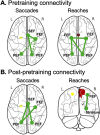Oculomotor functional connectivity associated with motor sequence learning
- PMID: 39514340
- PMCID: PMC11546180
- DOI: 10.1093/cercor/bhae434
Oculomotor functional connectivity associated with motor sequence learning
Abstract
Acquisition of learned motor sequences involves saccades directed toward the goal to gather visual information prior to reaching. While goal-directed actions involve both eye and hand movements, the role of brain areas controlling saccades during motor sequence learning is still unclear. This study aimed to determine whether resting-state functional connectivity of oculomotor regions is associated with behavioral changes resulting from motor sequence learning. We investigated connectivity between oculomotor control regions and candidate regions involved in oculomotor control and motor sequence learning. Twenty adults had brain scans before 3 days of motor task practice and after a 24-hour retention test, which was used to assess sequence-specific learning. During testing, both saccades and reaches were tracked. Stronger connectivity in multiple oculomotor regions prior to motor task practice correlated with greater sequence-specific learning for both saccades and reaches. A more negative connectivity change involving oculomotor regions from pre- to post-training correlated with greater sequence-specific learning for both saccades and reaches. Overall, oculomotor functional connectivity was associated with the magnitude of behavioral change resulting from motor sequence learning, providing insight into the function of the oculomotor system during motor sequence learning.
Keywords: motor sequence learning; oculomotor connectivity; resting-state functional connectivity; saccades.
© The Author(s) 2024. Published by Oxford University Press.
Figures








Similar articles
-
Dynamic Task-Related Changes in Electroencephalography Brain Connectivity During a Button-Press Task in Children with and Without Bilateral Cerebral Palsy.Brain Connect. 2025 May;15(4):162-174. doi: 10.1089/brain.2024.0096. Brain Connect. 2025. PMID: 40366203
-
Prescription of Controlled Substances: Benefits and Risks.2025 Jul 6. In: StatPearls [Internet]. Treasure Island (FL): StatPearls Publishing; 2025 Jan–. 2025 Jul 6. In: StatPearls [Internet]. Treasure Island (FL): StatPearls Publishing; 2025 Jan–. PMID: 30726003 Free Books & Documents.
-
Short-Term Memory Impairment.2024 Jun 8. In: StatPearls [Internet]. Treasure Island (FL): StatPearls Publishing; 2025 Jan–. 2024 Jun 8. In: StatPearls [Internet]. Treasure Island (FL): StatPearls Publishing; 2025 Jan–. PMID: 31424720 Free Books & Documents.
-
Altered brain connectivity in hyperkinetic movement disorders: A review of resting-state fMRI.Neuroimage Clin. 2023;37:103302. doi: 10.1016/j.nicl.2022.103302. Epub 2022 Dec 24. Neuroimage Clin. 2023. PMID: 36669351 Free PMC article.
-
Relationship between resting-state fMRI functional connectivity with motor and language outcome after perinatal brain injury - A systematic review.Eur J Paediatr Neurol. 2021 Jul;33:36-49. doi: 10.1016/j.ejpn.2021.05.007. Epub 2021 May 15. Eur J Paediatr Neurol. 2021. PMID: 34058624
Cited by
-
A caffeine and theacrine combination improves cognitive performance in tactical personnel under physically fatiguing conditions.J Int Soc Sports Nutr. 2025 Dec;22(1):2536146. doi: 10.1080/15502783.2025.2536146. Epub 2025 Jul 22. J Int Soc Sports Nutr. 2025. PMID: 40693646 Free PMC article. Clinical Trial.
References
-
- Alkan Y, Gohel S, Biswal BB, Alvarez TL. Functional connectivity in oculomotor movements. In: Proceedings of the 2010 IEEE 36th Annual Northeast Bioengineering Conference (NEBEC). New York, NY, USA: IEEE, 2010. p. 1–2. 10.1109/NEBC.2010.5458273. - DOI
-
- Andrushko JW, Rinat S, Greeley B, Larssen BC, Jones CB, Rubino C, Denyer R, Ferris JK, Campbell KL, Neva JL, et al. . Improved processing speed and decreased functional connectivity in individuals with chronic stroke after paired exercise and motor training. Sci Rep. 2023:13:13652. 10.1038/s41598-023-40605-8. - DOI - PMC - PubMed
-
- Aznárez-Sanado M, Eudave L, Martínez M, Luis EO, Villagra F, Loayza FR, Fernández-Seara MA, Pastor MA. Brain activity and functional connectivity patterns associated with fast and slow motor sequence learning in late middle adulthood. Front Aging Neurosci. 2022:13:778201. 10.3389/fnagi.2021.778201. - DOI - PMC - PubMed
Publication types
MeSH terms
Grants and funding
LinkOut - more resources
Full Text Sources
Medical

